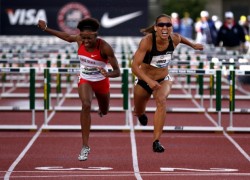
When returning Olympic gold medalist Dawn Harper crossed the finish line of the women’s 100-meter hurdles, she probably thought it was her moment. Her blazing time of 12.73 seconds made her, once again, the fastest female hurdler in America. She should be the face of women’s 100-meter hurdles.
But she’s not.
Across newspaper headlines, across the Twittersphere and across many of our minds, the story of the women’s hurdles isn’t Harper’s continued dominance, Harper’s return from an often career-eviscerating arthroscopic knee surgery or Harper’s odds of repeating her performance at the Beijing Olympics.
No, The story is media darling Lolo Jones eking out a London berth with a third-place finish (12.86) after just barely squeezing into the finals the day before.
It was Lolo — not Harper — who was a featured guest on the Jay Leno Show. It was Lolo — not Harper — who finds herself plastered all over across papers, TV screens and dorm room walls. At the press conference, the media was more interested in Lolo’s third-place finish than Harper’s victory. When asked if she felt underappreciated, according to ESPN’s Grantland, Harper responded, “definitely.”
If this were to be based solely on talent, solely on performance and what each athlete has to show for it, Harper would be — without question — the first thing that came to our minds when we think of women’s hurdles. But Lolo has a certain recipe that often supersedes talent and achievement in today’s Hollywood sport’s world.
Catchy, unforgettable nickname: From the first time you hear “Lo” and “lo” fuse together and become a name, it ingrains into your mind. Though her real name is Lori, the moniker “Lolo” has taken over her identity. We all love repeating those “Lo’s” (even if they are remnant of a Lil’ Jon track).
Public sex life (or lack thereof): Lolo’s documentary, shown on ESPN and HBO, gets into the details of her celibacy, and how she’s “had plenty of opportunities” to give up her virginity. Like Tim Tebow, her devout faith and public purity adds to her popularity — more so than her on-the-field performance (Side note: A headline on USA Today read, “Lolo Jones wants to invite Tim Tebow to church.” No, I’m not joking.)
Trials and tribulations: An impoverished upbringing, a failure to win gold at Beijing, a barely squeezing into the Olympics this year — Lolo’s got “underdog’s redemption story” tattooed all over her forehead.
And, sadly, good looks: Beautiful, hypnotizing eyes, silky, light brown skin and hair, Olympic-grade body — Lolo Jones is one of the most beautiful-looking women I’ve ever seen. And it’s no secret that her striking image is a huge part of her marketability and her fame.
But this one is the hardest to come to grips with, for me. Nowhere in men’s sports does good looks translate to money and fame quite like they do in women’s sports. In a world dominated by male fans, male reporters, male CEOs of sports agencies — all-male everything — a female athlete’s look can be the difference between unsung hero status and media superstar. Men don’t associate a man’s value with the way he looks (otherwise, Shaquille O’Neal and Charles Barkley would be bankrupt), but a man will typically pay a lot more attention to an athlete who they’d love to see in SI’s Swimsuit Edition.
Making the Lolo Joneses of the world more marketable than the Dawn Harpers is a disservice to the very meaning of women’s sports.
Make no mistake — Lolo is no scrub. A world-champion in the women’s 60-meter hurdles, boasting a 12.29 finish in the 100-meter hurdles in the ’08 Olympic Trials, Jones isn’t all media and no talent. But when an Olympic gold medalist as impressive as Harper leaves the podium and press conference feeling under the radar — even though she’s proven herself to be the best in America — something is terribly wrong. After all, track and field is supposed to be a world that judges its athletes not by the marketability of their brands but by the times that they finish.
